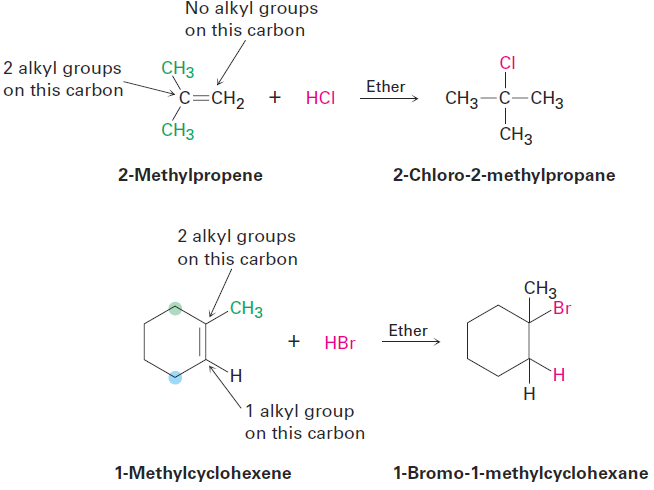


 علم الكيمياء
علم الكيمياء 
 الكيمياء التحليلية
الكيمياء التحليلية 
 الكيمياء الحياتية
الكيمياء الحياتية 
 الكيمياء العضوية
الكيمياء العضوية 
 الكيمياء الفيزيائية
الكيمياء الفيزيائية
 الكيمياء اللاعضوية
الكيمياء اللاعضوية 
 مواضيع اخرى في الكيمياء
مواضيع اخرى في الكيمياء
 الكيمياء الصناعية
الكيمياء الصناعية |
Read More
Date: 17-5-2017
Date: 20-1-2020
Date: 7-7-2019
|
Orientation of Electrophilic Additions: Markovnikov’s Rule
Look carefully at the electrophilic addition reactions shown in the previous section. In each case, an unsymmetrically substituted alkene gives a single addition product rather than the mixture that might be expected. For example, 2-methylpropene might react with HCl to give both 2-chloro-2-methylpropane and 1-chloro-2-methylpropane, but it doesn’t. It gives only 2-chloro-2-methylpropane as the sole product. Similarly, it’s invariably the case in biological alkene addition reactions that only a single product is formed. We say that such reactions are regiospecific (ree-jee-oh-specific) when only one of two possible orientations of an addition occurs.

After looking at the results of many such reactions, the Russian chemist Vladimir Markovnikov proposed in 1869 what has become known as Markovnikov’s rule. Markovnikov’s rule In the addition of HX to an alkene, the H attaches to the carbon with fewer alkyl substituents and the X attaches to the carbon with more alkyl substituents.

When both double-bonded carbon atoms have the same degree of substitution, a mixture of addition products results.




|
|
|
|
للعاملين في الليل.. حيلة صحية تجنبكم خطر هذا النوع من العمل
|
|
|
|
|
|
|
"ناسا" تحتفي برائد الفضاء السوفياتي يوري غاغارين
|
|
|
|
|
|
|
نحو شراكة وطنية متكاملة.. الأمين العام للعتبة الحسينية يبحث مع وكيل وزارة الخارجية آفاق التعاون المؤسسي
|
|
|